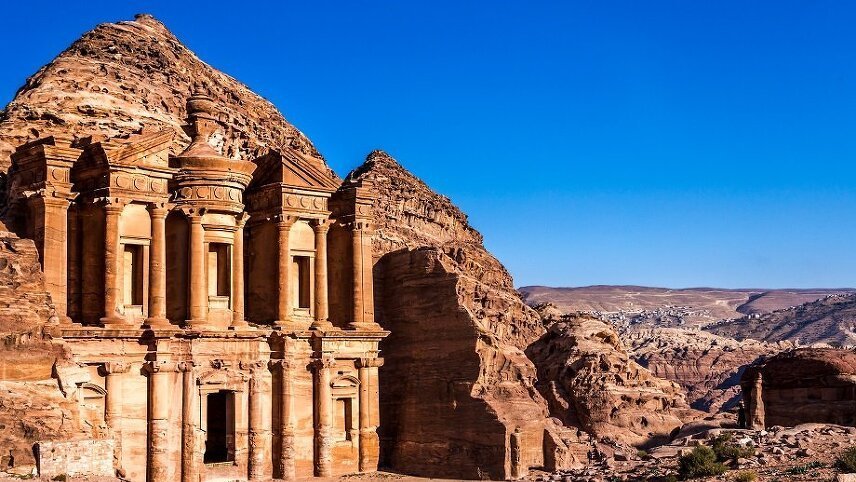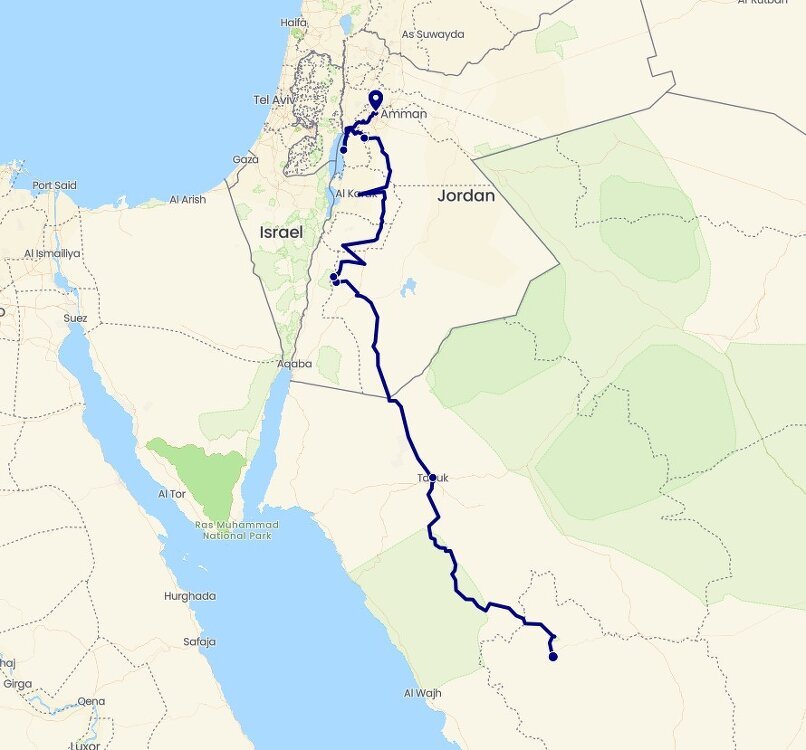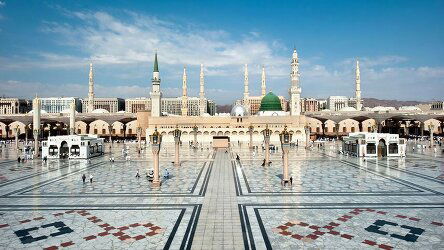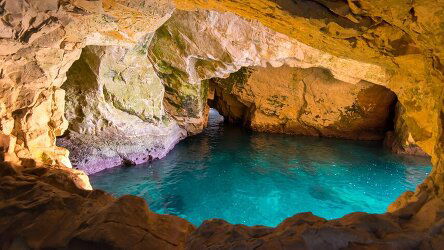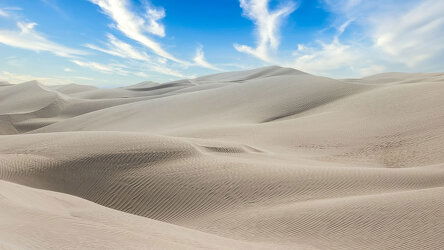Overview
Itinerary
Welcome to Jordan! On arrival in Amman, you will be met and transferred to the lowest point on earth, the Dead Sea. Check into your hotel, the rest of the day is at leisure. Float on the salty waters, cover your body with the dark mud from the shores. Since the days of Herod the Great, people have flocked in search of its curative secrets. The area is characterised by high annual temperatures, low humidity and high atmospheric pressure. The air is extremely oxygen rich. With the highest content of minerals and salts in the world, the Dead Sea water possesses anti-inflammatory properties, and the dark mud found on its shores has been used for over 2,000 years for therapeutic purposes. Stay: Holiday Inn Resort or similar
Follow a scenic route, as you make your way towards Petra. Visit the impressive Mt Nebo which overlooks the Jordan Valley and parts of the Holy Land. According to the Bible, this is the place where Moses viewed the Promised Land before he died and this is alleged to be his burial place. Continue on to the town of Madaba. See the famous 6th century mosaic map of Jerusalem and the Holy Land at St. George's Church, as well as the other mosaics in the Archaeological Park. Travel along the famous ancient caravan route of the King's Way. Stop for a short photo stop in Wadi Al Mujib, a great wide valley with magnificent geological formations, identical to the Arnon River of the Hebrew Bible. Continue to the remains of the Crusader castle, Kerak. Explore the underground passageways, enjoy the view and imagine how the forces of Salah ad-Din besieged this stronghold several times. Stay: Dana Guesthouse or similar (B/D)
Get to know your local guide and set off from Dana Village, as you explore the second largest nature reserve in Jordan. Pass by terraced gardens, walk along dramatic mountains and sweeping valleys with changing colours and spectacular views of Wadi Dana. Your guide will share with you about life in the village, the reserve and its fauna and flora. Once returning to the village, it is time to head to Little Petra, which most likely served as a caravan stopping point enroute for Petra. Enter the small site through a narrow gorge, known as Siq Al Barid, to see temples, tombs and water channels carved in the sandstone. One of the caves shows the remains of a Nabatean fresco painting.
This is where many religious activities were held, including the Feast of Drink, when the king of the Nabataeans hosted celebrations and provided drinks for his guests. There is also a cave with the remains of a fresco painted by the Nabataeans that represented grape vines, which shows that this was the area for wine production. In the Siq Al Barid, the Nabataean irrigation system, which distributed water through long channels, provides evidence of the greatness of this system with reservoirs carved into the rock and dams. Continue to your hotel in Petra for the evening. (B,PL) Stay 3 Nights: Old Village Resort or similar
It's all about on foot adventure today! Petra offers several trails to explore more of the vast, ancient city. Today, take the back route from Little Petra to the Monastery El Deir. Starting from Little Petra, once a caravan stopping point, where you see sandstone façades to a much smaller scale than Petra, pass by the remains of the Neolithic village Beidah, walk across open farmland before entering a mountainous area. The path opens up to the impressive façade of the Monastery El Deir, 45 metres high, cut in the sandstone rock. Explore the monument and its surrounding areas with great views over the Wadi Araba. Follow 800 stairs down to the lower parts of Petra, where you will follow the main trail leading to the main gate. The hike is moderate and takes about 4 hours to reach the Monastery. There is one exposed area which may be a little challenging for people afraid of heights. (B,PL)
Set off with your local guide and hike / scramble the Al Madras path to the Treasury Viewpoint. Stand in awe, as you soak in the view below and imagine what it must have been like traversing the desert in the Crusader times. Back on the main trail, pass the narrow canyon, the so-called Siq, with its colourful sandstone. At the end, you will be rewarded with a view of the most beautiful monument, the Treasury. Continue via the Street of Facades to the Royal Tombs and Pharaoh's Castle. You will have free time to explore Petra on your own this afternoon. For those still feeling active, why not climb the stairs to the High Place of Sacrifice. (B)
An early start this morning, as you head two hours towards the Al Muddawara Border, where you will cross into Saudi Arabia.
Head to the area of Madian or as they call it now Al Bad'. Your first stop will be at the ship rock, a natural rock formation. Continue to the Catalina Airplane wreck in Ras Alsheikh Hameed. The highlight of today will be a visit to Tayyeb Ism.
While getting closer to a nice little palm grove at the bottom of the cliffs, the mountain side that looks towards the Gulf reveals the stunningly high edges of a narrow canyon whose entrance is just few dozen meters from the sea. A wooden bridge spanning the rocks allows you to carry on deeper into the meanders of this massive breach through the mountain.
Continue to Jethro's Cave, a collection of Nabatean tombs. These tombs are carved into the rocks, decorated in an artistic way similar to the Nabatean tombs found in Hegra and Petra. You will have a chance to see the sunset at this gorgeous valley before we head to your hotel in Tabuk. Stay: Ewaa Express Hotel or similar (B/L/D)
Hit the road for 2.5 hours towards AlUla where you will explore the area between Jabal Ikma and Dedan. The oasis city of Dedan was known as Lihyan and the capital of two old Arabian kingdoms in the 1st millennium BCE, close to the trade routes. Excavations revealed remains of large fortified cities. East of the city, you will find the famous Lion Tombs carved into the cliff of Jabal Dedan.
A short ride takes you to Jabal Ikmah, an open library of Aramaic, Dadanitic and Nabataean inscriptions in a beautiful desert landscape. Your next stop will be at one of AlUla‘s local palm farms, where your host will share the history of the farm and the daily business trade. Taste the local sweet dates and fresh fruit grown in the plantation. Finish your tour in the heritage village of AlUla, also known as Ad-Deerah or old town, which is a traditional Arabian mud brick village where people of the oasis lived eight centuries ago and inhabited it until the 20th century. It was built on a higher part of the valley in order to be clear from the floods that can occur during the rainy season. One of the reasons it evokes such a deep sense of emotion, is that it was actually inhabited in the not-so-distant past. AlUla Old Town is located in the narrowest part of the AlUla Valley. Built on a slight elevation, the town is overlooked by the Musa bin Nusayr Castle, a citadel dating back approximately to the 10th century.
This evening, you have the option to participate in star gazing at Al Gharameel. Experience the enchantment of the desert with stargazing led by Husaak's star guide. Surrounded by Gharameel's mystical rock formations, you will look up to a blanket of stars and enjoy a traditional grilled dinner alfresco. *Note this activity is weather dependent. Stay 2 Nights: Shaden Resort or similar (B/L/D)
For the early risers, why not enjoy a hot air balloon over the expansive desert, or take a 30 minute helicopter flight? Get ready to view AlUla from above, with a 30-minute helicopter journey with your pilot for an exhilarating flight that takes you over AlUla's seven most famous landmarks and heritage sites.
The first of these will be the monumental Jabal AlFil (Elephant Rock), AlUla's most famous natural geological rock formation. Next, fly head over to Hegra, a UNESCO World Heritage site and the southern capital of the Nabatean Civilisation, with its ancient tombs carved deep into the red and golden rocks.
Your pilot will now turn towards the west, and in the distance, you will see Maraya, the Guinness World Record holder for the world's largest mirrored building reflecting the sun out to the sky, shining brightly like a diamond in the desert.
As your pilot turns south and takes you over the AlUla's three other most important heritage sites of Jabal Ikmah (the open-air library), back down over Dadan (the capital of the Dadan and Lihyan kingdoms) and lastly, over the AlUla Old Town (the 12th-century medieval city).
As you land back at Fursan Village, it is then you will genuinely appreciate the beauty, heritage and sheer majestic landscapes of this unique destination.
For those who prefer a slower start, your day starts with a visit to the most popular historical site in Saudi Arabia, Madain Saleh. Known previously as Hegra, it is the first attraction in Saudi Arabia to be listed as a UNESCO Word Heritage Site. Madain Saleh was the second largest city of the Nabataean Kingdom, whose capital Petra, you visited a few days ago. In Madain Saleh, 110 tombs can be explored, while learning about the ancient people and culture of AlUla, many with numerous inscriptions. The area called Jabal Ithlib, leads to a Triclinium, Diwan in Arabic, dedicated to councils and rituals.
Evidence of human presence and use of the site dates back beyond the 1st millennium BCE, and was the location of the Nabataean city from the end of the 1st millennium BCE into the 1st millennium CE. The city was at its peak from the late 2nd century BCE to the 2nd century CE.
Along with the wondrous tombs, which were used to lay Nabataean elite to rest, visitors will find wells and stone-lined water channels demonstrating the civilisation's expert craftsmanship. Roman influence is also present in the form of defensive walls, gates and towers that once encircled the city.
This afternoon, set off on the Adventure Trail which is an 8 km long historical treasure trove with clusters of pictographs that are two-thousand years old along the trail. The Adventure Trail will take you through the story of the people who lived in this area thousands of years ago; their writings are on the wall, how they lived, how they fought, and how they connected.
The trail takes about 3-4 hours to hike through, depending on your fitness level. The Adventure Trail is the best representation of AlUla's rich heritage and beautiful nature. The Adventure Trail offers a variety of terrains of different volcanic rocks and soft sand. The alternating water and air erosion is apparent throughout the hike. The canyon was carved by water, forming a variety of sections from narrow to wide, along with very rough sandy walls. The trail is effectively flat, as its elevation merely drops 95 metres from the starting point at 1,020 metres to the end point at 925 metres.
The long walls of the canyon provides constant shade throughout the day, which makes it a perfect place to hide or hang out during the hot summer months. This quality can explain the multiple clusters of ancient pictographs on the canyon's wall. While this place is known for its pictographs, it also has a variety of flora and fauna. The canyon can collect rain-water in some areas along the trail during the winter months, therefore, it may require you to go knee deep into water ponds which adds to an already great adventure. (B/L/D)
Say goodbye to beautiful Saudi, as you transfer to AlUla Airport for your departure. (B)
Trip Inclusions
- Float in the Dead Sea
- Explore Dana Village, the second largest nature reserve in Jordan
- Hike from Little Petra to Monastery El Deir
- Trek into Petra
- Walk through Wadi Dissah, a 15 km long sandstone massif with beautiful rock formations
- Discover the oasis city of Dedan, the capital of two old Arabian kingdoms in the 1st millennium BCE
- Wander through AlUla's old town, a traditional Arabian mud brick village
- Admire Madain Saleh, the second largest city of the Nabataean Kingdom after Petra
- Hike the 8km Adventure Trail with clusters of pictographs that are two-thousand years old
- Return airport transfers
- 8 nights accommodation
- Meals as per the itinerary
- Services of an English speaking local guide
- National Park fees
- Private air-conditioned transportation
- Sightseeing as per the itinerary
- Bottled water
- Entrance fees
- International flights
- Drinks unless otherwise mentioned
- Optional excursions
- Visas
- Travel Insurance
- Tips
- Inoculations
- Items of a personal nature
- Anything not mentioned in the itinerary
- Accommodation, itinerary and inclusions subject to change.
- Disruptions to itinerary may occur.
Availability
 USD
USD
Your Global Journeys Travel Advisor will check the availability of your departure date when you enquire. Additional savings may apply. We guarantee the lowest price in USA. T&C’s apply.
Tour & cruises prices are per person. Prices shown have savings applied, are subject to availability and may be withdrawn at any time without notice. Pricing and trip details are correct at this point in time, however are subject to confirmation at the time of booking and are subject to change by Crooked Compass. For cruise itineraries, cabin images are sourced from Crooked Compass. These should be treated as indicative only. Cabin inclusions, upholsteries and room layout may differ to the image(s) shown depending on the ship selected and your sailing dates.
